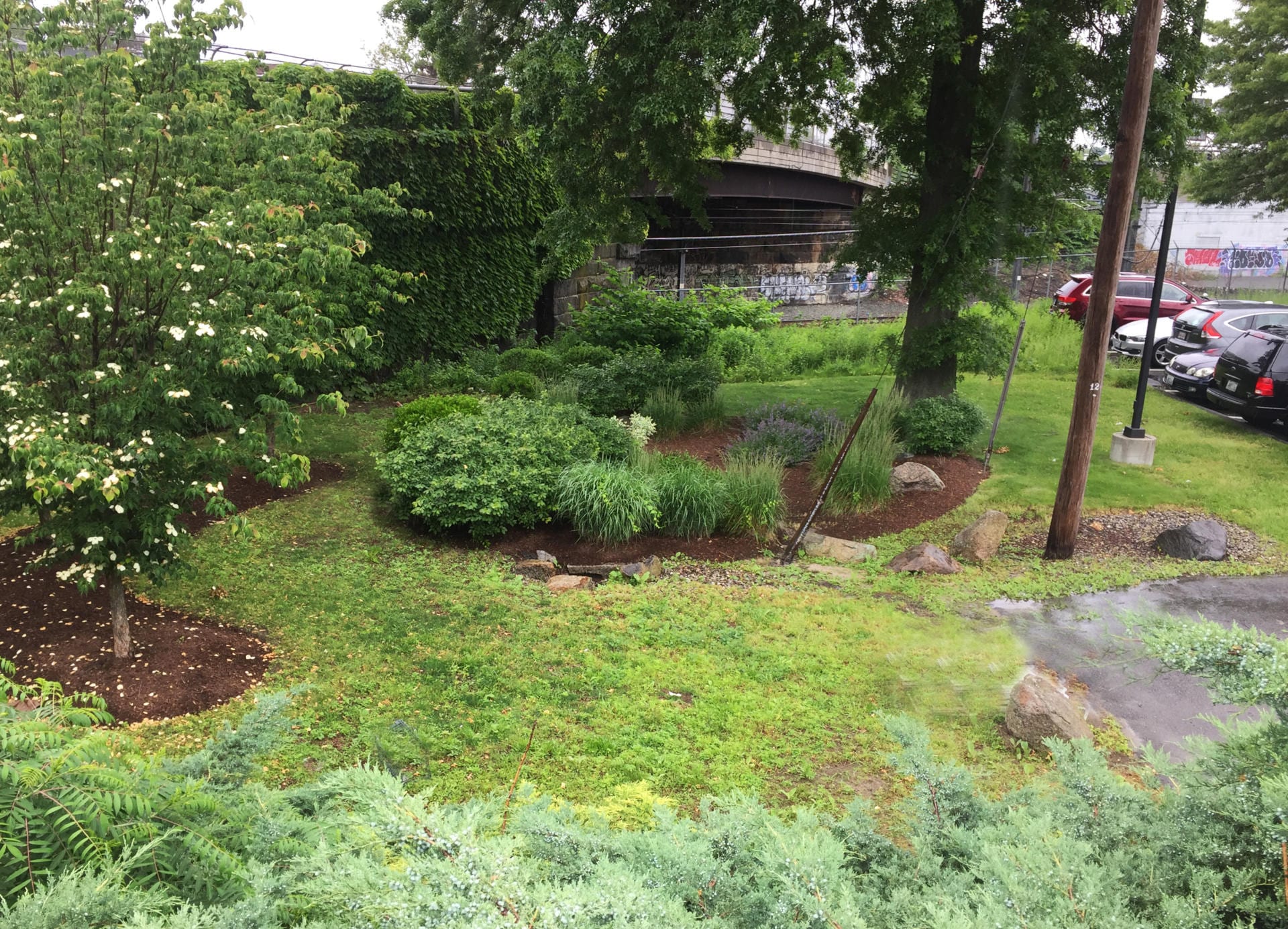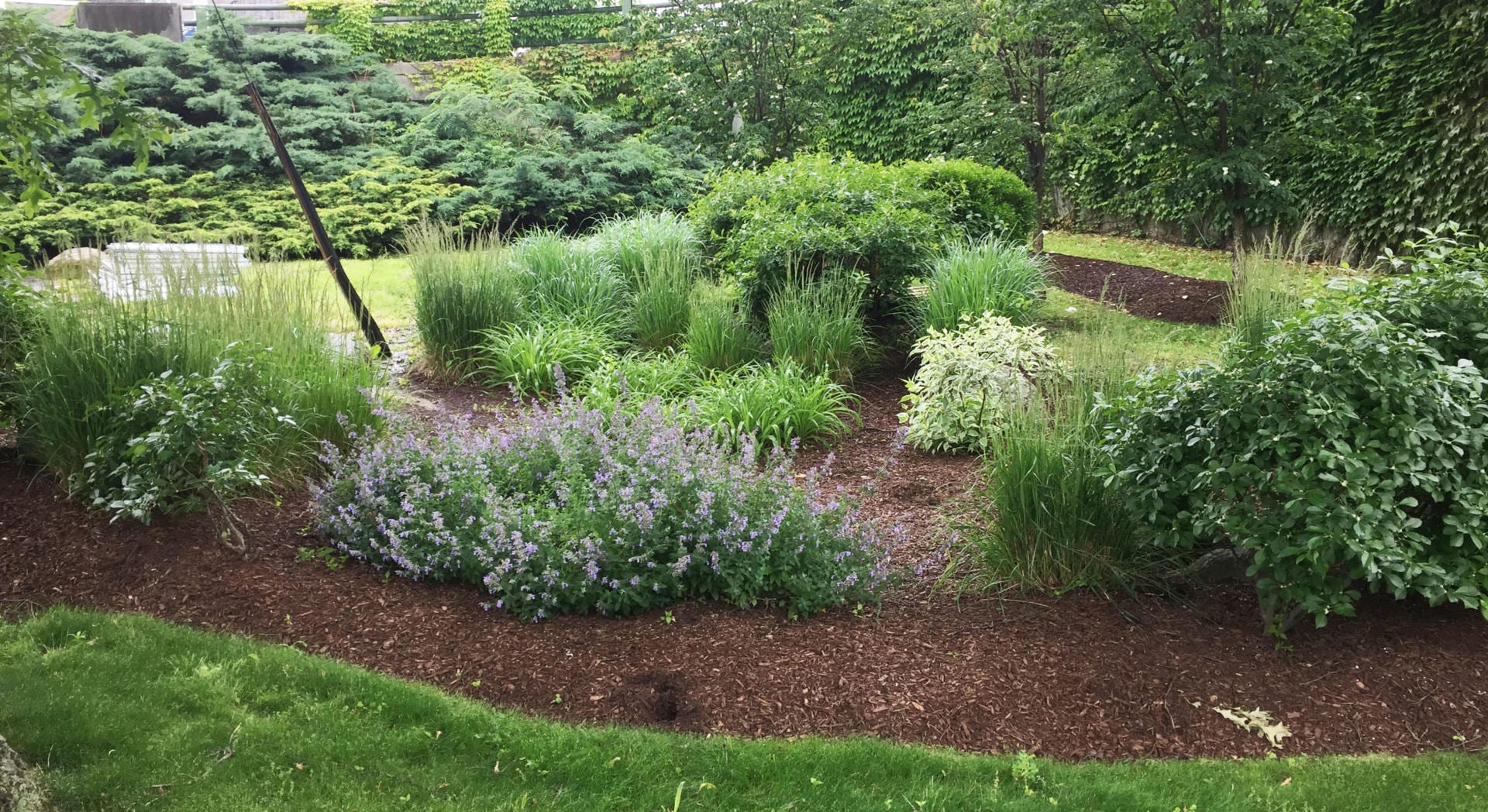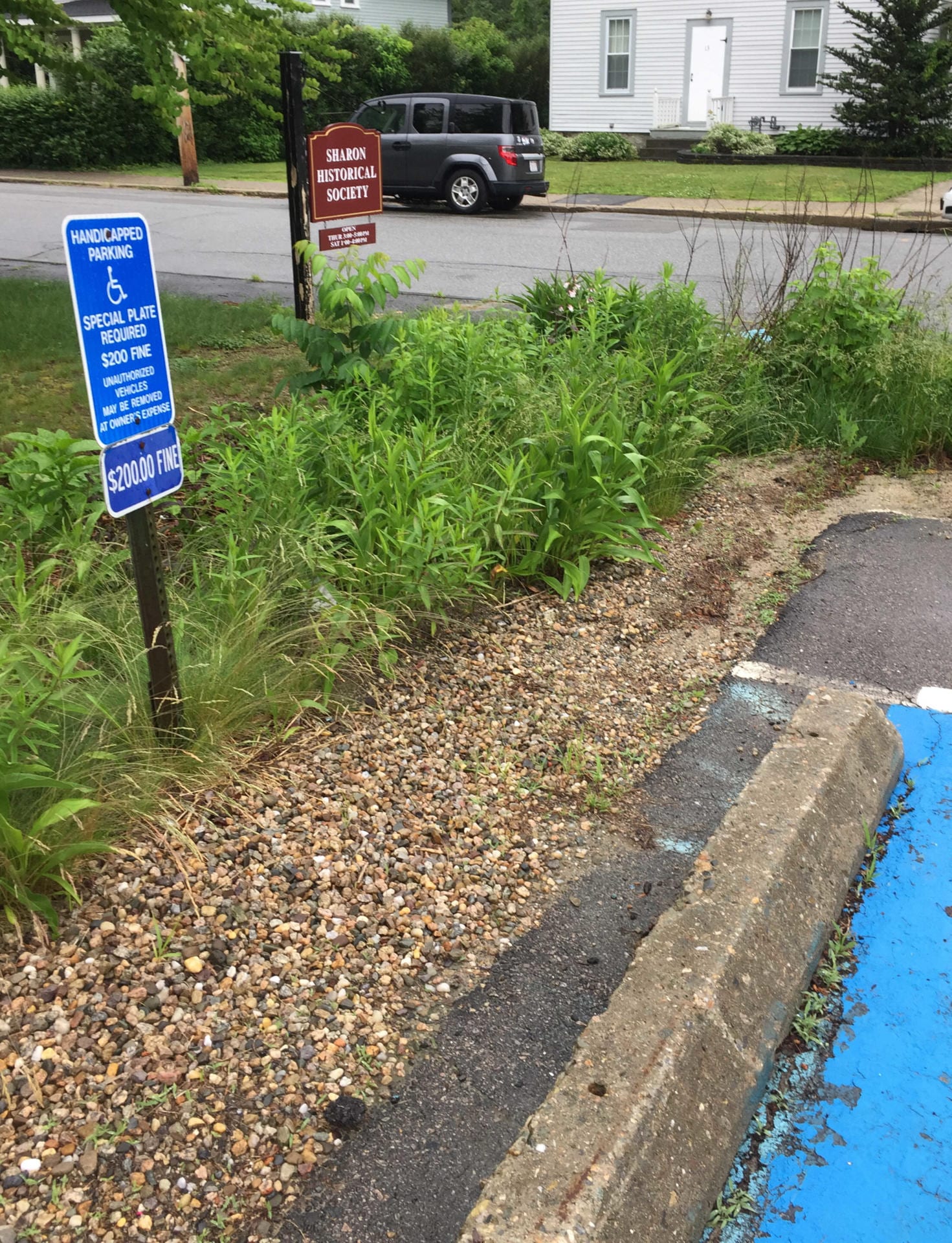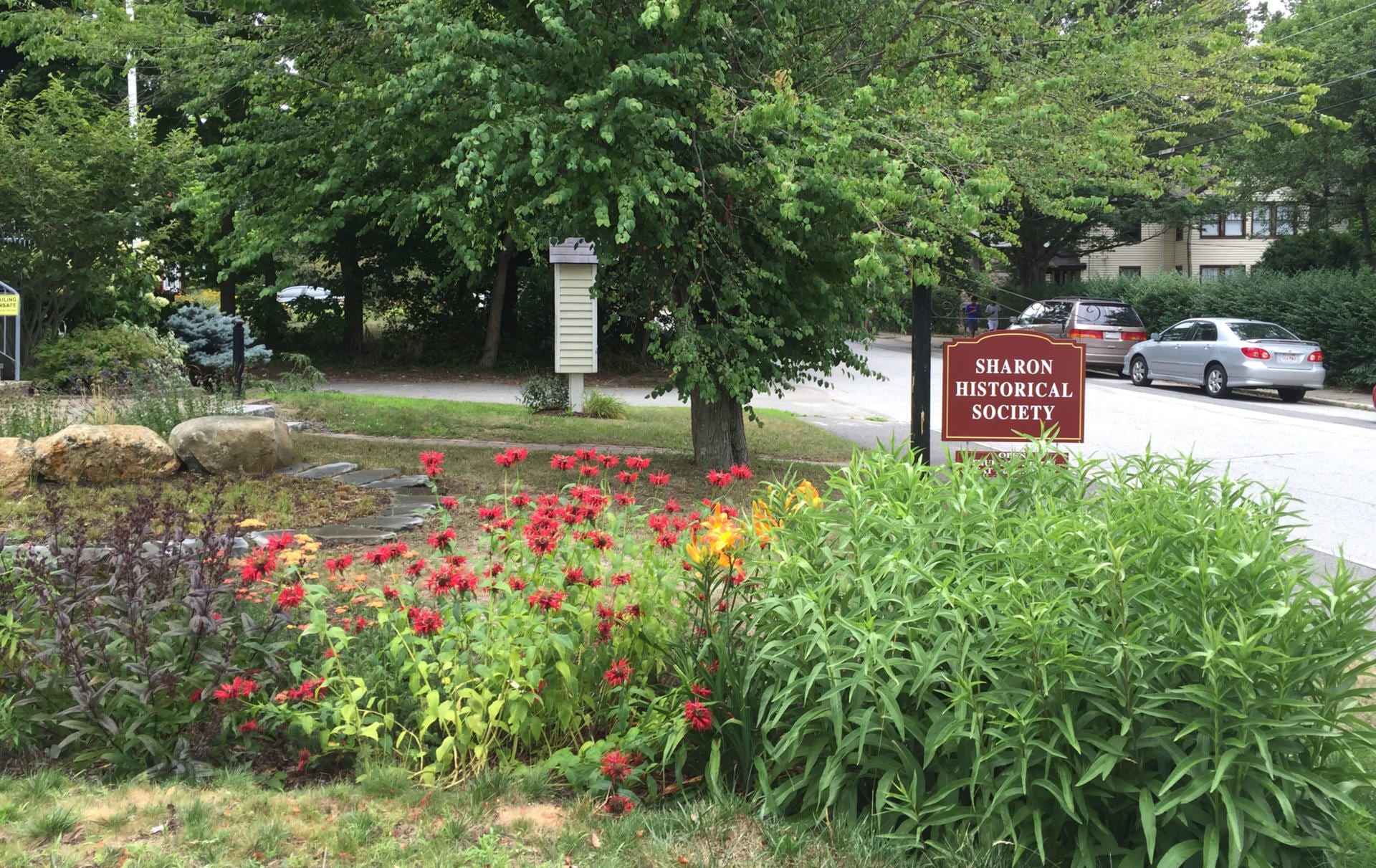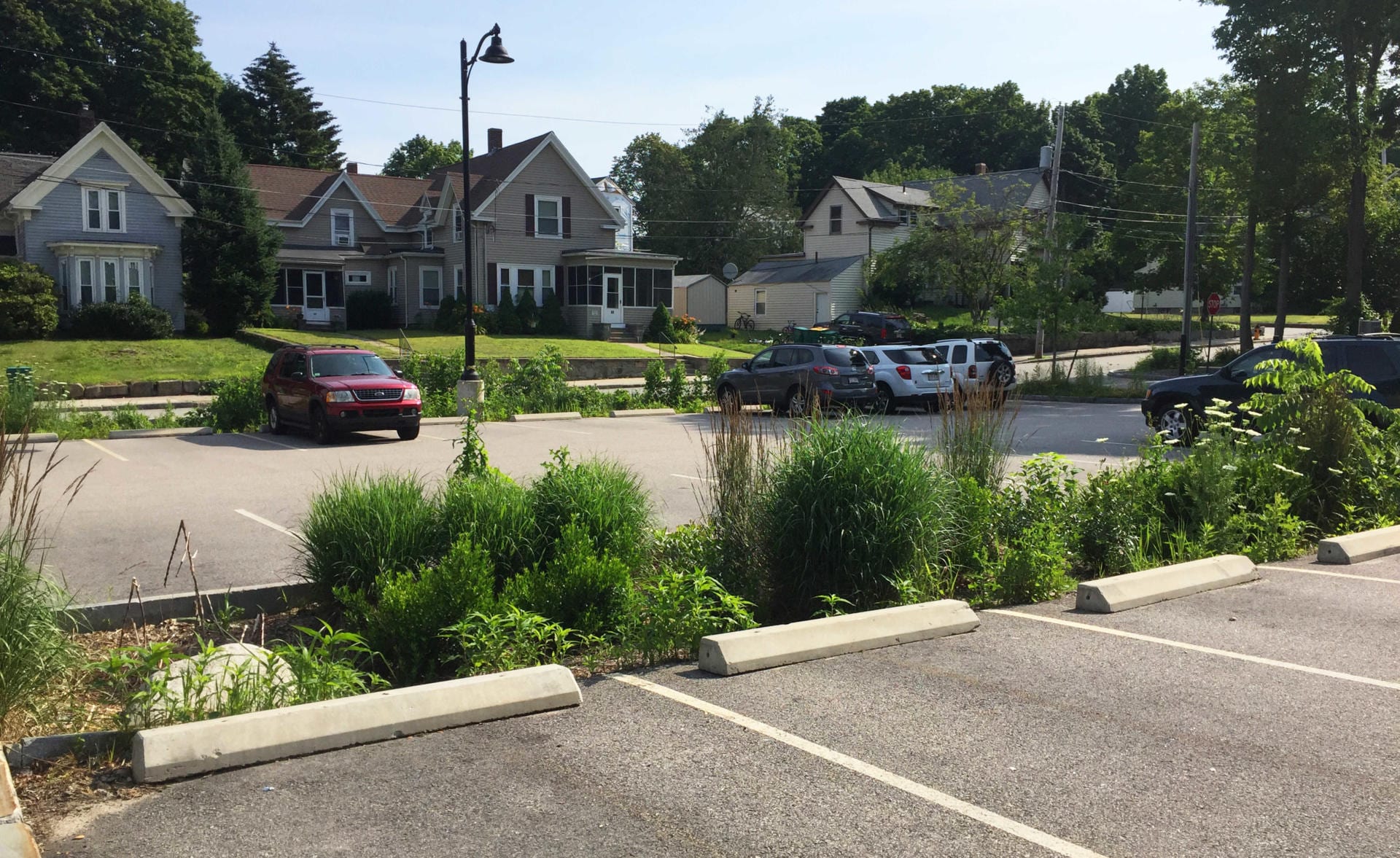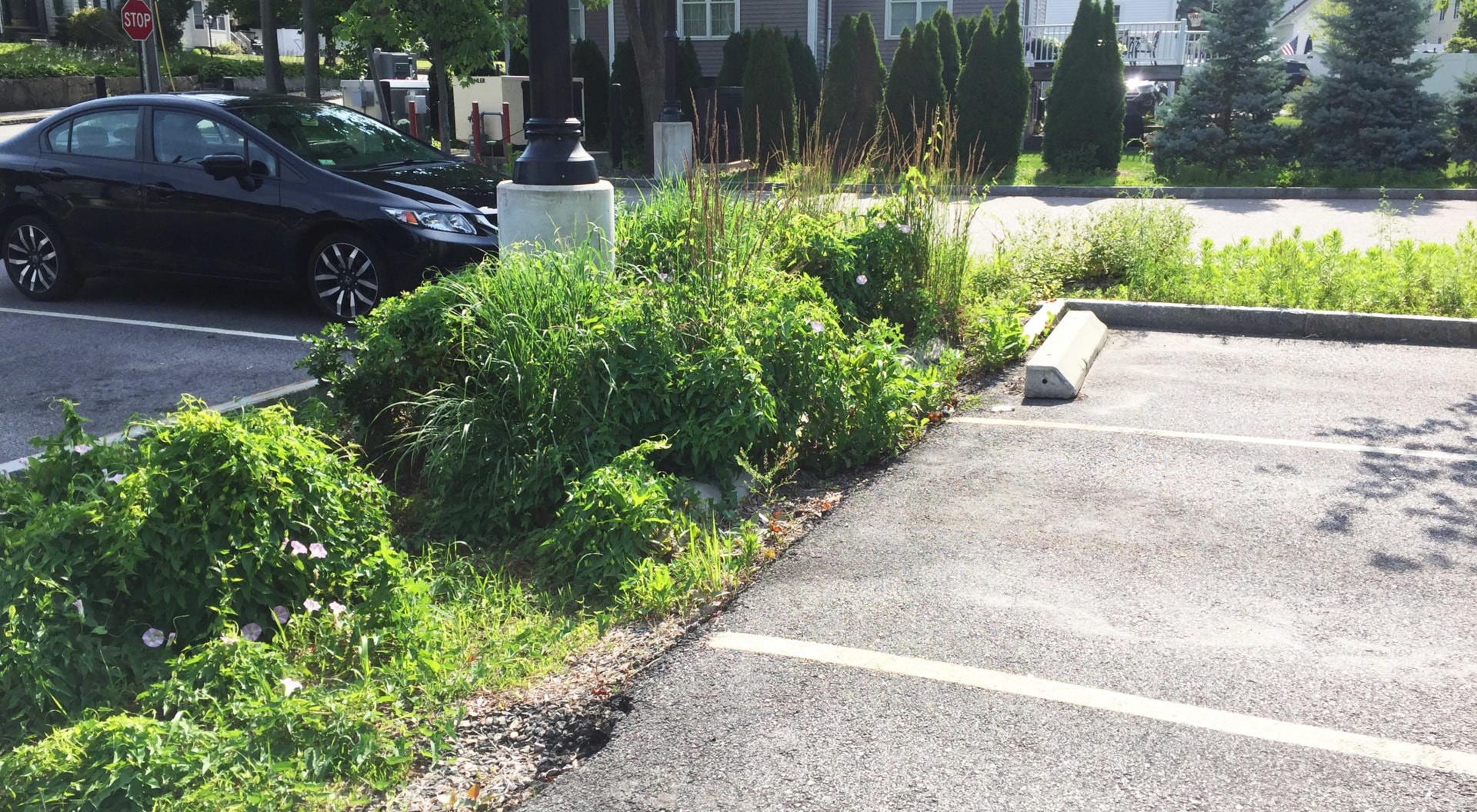By Amanda Sloan
Recalling the steady drum of rain on my roof last night leads me, this morning, to wonder how my rain gardens are doing. Are they still catching, holding, and infiltrating storm water from the impervious areas for which they were designed? Are they, if not perfectly tidy, at least nice to look at? Are they free of trash? How do the forebays look? Which plants have died, and which have flourished? Is there evidence the rain garden is providing food and habitat for wildlife? Today, I’m going to head out and check a few of them that are close by, hoping to answer these questions.
Why Rain Gardens?
Catching, holding, and infiltrating water is an ancient human practice in agriculture and urban infrastructure. But, the use of the “modern” rain garden as a common element of Low Impact Design has been prevalent only for perhaps 25 years. Because the thinking behind a rain garden’s function is intuitive and based on centuries of observation and practice in landscape hydrology, state and local storm water authorities have been quick to promote the rain garden as an important part of green infrastructure. However, even for the oldest rain gardens around today, it’s still early days. We’re still learning to perfect them. Rain garden specifications are constantly being modified and improved as trial-and-error testing in real landscapes progresses.
For about ten years, I have been including rain gardens in my landscape designs as often as possible where they could be useful. This has included designs for residential, institutional, commercial, and civic projects. Now, I like to visit these rain gardens when I can to get an idea of what has worked and what needs further thought.
Tracking Performance
Today I am visiting three rain gardens installed between four and eight years ago: a commercial rain garden at a medical facility, an institutional rain garden at a nonprofit organization, and a civic rain garden in a town center. All the rain gardens are associated with parking lots and were implemented to provide a green solution for storm water runoff from the parking areas. All are “non engineered” rain gardens with direct infiltration to the aquifer below through a filter planting medium and with no outlets or underdrains.
It’s always interesting to visit landscapes that we, as designers, worked on years ago. Anticipation, trepidation, possibly disappointment – and, more often than not, an equal measure of delight – are the feelings we experience as we note whether the plants matured as we envisioned, how materials have weathered, if proper maintenance is happening, and if the place is being used as intended.
If the landscape includes a mature rain garden, an even more complex level of evaluation must also take place. A rain garden’s most important feature is that it is functional. It must catch, hold, and infiltrate storm water from a designated area. It must not add pollutants to the infiltrated storm water. And if, on top of successful functionality, the rain garden is beautiful, provides food and habitat for wildlife, and is a pleasure to visit, well then, we can feel delighted indeed!
In my rain garden assessments this morning, I experience the full range of feelings. I also realize that the very important measure of rain garden functionality is not possible in a quick checkup. This is the measure of how well the system is removing pollutants from the incoming storm water. An accurate check of this requires both special equipment and forethought in the design. One must be able to easily sample the storm water flowing into the garden, and the same water after it has filtered through the garden. Today, only experimental rain gardens, usually associated with universities, have these capabilities. There are a number of design models, based on this research, that universities have made available for rain garden designers; however, a model cannot always take into account all variables in a real situation. One common finding in older-design rain gardens has been that they export nitrogen rather than cleansing it from storm water, but we designers cannot know if this is happening unless we can test our rain gardens – a consideration for future designers!
Assessing the Gardens
So, how did the three measure up? We’ll go from best to worst.
#1 Medical Office Rain Garden, Providence, Rhode Island
(Installation of this rain garden is described in the ELA Newsletter article “Ecological Design Creates Oasis at Urban Medical Facility,” December 14, 2012)
Designer’s ratings 8 years after installation:
Beauty—Delightful
Function—Delightful
Habitat Value—Delightful
Maintenance—Delightful
The oldest rain garden in the group of three is still beautiful and functional. Part of a low impact landscape at a medical facility and qualifying as a commercial rain garden, this installation benefits from the regular maintenance a commercial owner can provide. The garden is free of trash, the mulch filter layer is fresh, the plants are flourishing. The “bowl” shape of the garden is intact and well delineated; storm water is being infiltrated; and the gravel and grass forebay strips are catching sediment before it is carried into the garden. Successful, bee-laden plantings that have survived their years here include Ilex glabra and verticillata, Panicum virgatum, Calamagrostis, Cornus alba ‘Ivory Halo,’ Nepeta, Hemerocallis. Because the forebay is actively catching sand from parking lot storm water, it provides a medium for volunteer weeds, which could be cleared at the next maintenance.
#2 Sharon Historical Society Rain Garden, Sharon, Massachusetts
Designer’s ratings 4 years after installation:
Beauty—Nice
Function—Delightful
Habitat Value—Delightful
Maintenance—Needs Improvement
The most noticeable feature of this younger rain garden is that it is functioning very well. It is observably catching and infiltrating storm water from a parking lot adjacent to the Sharon Historical Society, intercepting the flow before it reaches a street storm drain. This institutional rain garden is maintained by volunteers twice per year. Today, the presence of some trash in the garden, last year’s flower stalks not pruned; the need for a new mulch filter layer, and the need for a forebay cleanup speak to the importance of having a regular professional maintenance plan in place. The blooming Monarda, Penstemmon, Hemerocallis, and healthy Solidago sempervirens, Panicum virgatum, and Aster novae-angliae support a variety of busy insects. The only original plant that seems to have disappeared is Baptisia australis.
#3 Municipal Parking Lot Rain Gardens, Easton, Massachusetts
Designer’s ratings 6 years after installation:
Beauty—Trepidation
Function—It’s Working
Habitat Value—Delightful
Maintenance—Disappointment
This system of parking lot islands built as rain gardens is certainly functioning to catch and infiltrate storm water from the asphalt parking surface sloped across a hill. From a distance, the structure of the plantings is still noticeable. Up close, the problems faced by rain gardens that are maintained (or not) in high-traffic town centers by overworked DPWs are greatly evident. The gardens are marred by trash and unpruned stems. The filter mulch has never been refreshed. Two of the wheel-stops used at the head of each parking space to stop cars from rolling over the flush edge of the rain garden have been snowplowed into the garden and never pulled out. The plantings are overwhelmed with local volunteers (sometimes known as weeds), but, the ecologist in me delights in an odd but important detail. The weeds, many in flower, have attracted swarms of important insects! In particular, I note two species of beneficial parasitoid wasps sipping nectar. This rain garden scores the highest for habitat value of those I have visited today.
In Conclusion
As I make my way back to the office, I reflect that rain garden design is a work in progress. Re-checking the gardens reveals the areas where we designers have succeeded (grading, plant selection, materials) and those that still need work (maintenance plans, in-situ testing of filtered storm water for pollutants). I’ll take today’s lessons with me to my next project with rain gardens. Meanwhile I would like to share two university-based websites that offer guidance in design modeling for rain gardens, especially around maintenance, monitoring, and pollutant removal:
http://stormwaterbook.dl.umn.edu/developing-assessment-program/monitoring
https://www.unh.edu/unhsc/specs-and-fact-sheets-0
About the Author
Amanda Sloan, RLA, ASLA, is a Massachusetts-based landscape architect with more than 25 years of experience on ecological projects. She has worked with design firms both large and small, most recently on large public landscapes with BETA Group, Inc., a multidisciplinary design firm. She specializes in parks, rain gardens, multi-use trails, and native plants.
***
Each author appearing herein retains original copyright. Right to reproduce or disseminate all material herein, including to Columbia University Library’s CAUSEWAY Project, is otherwise reserved by ELA. Please contact ELA for permission to reprint.
Mention of products is not intended to constitute endorsement. Opinions expressed in this newsletter article do not necessarily represent those of ELA’s directors, staff, or members.


